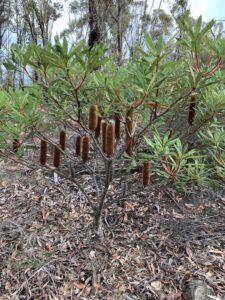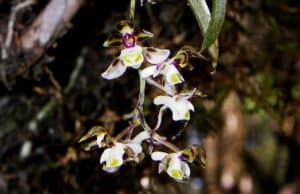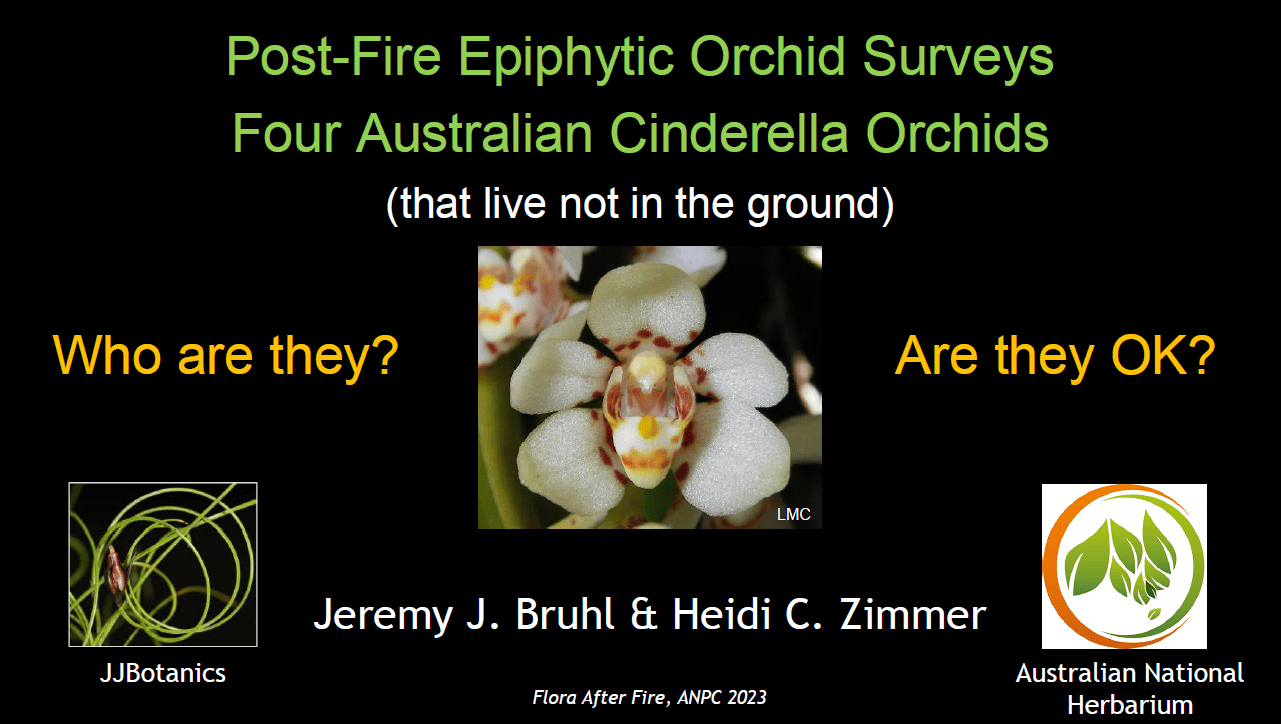Preventing rare plant extinctions after the Black Summer bushfires
Background
The extensive fires in south-eastern Australia in 2019/2020 burnt many plant species (and their habitats) that were not considered threatened at the time, but had the potential to increase the risk of these species declining to the point of becoming threatened in the near future.
Many factors determined the ability of plant species to successfully recover after the fires, including fire severity, fire frequency, drought and a changing climate, along with impacts of post-fire grazing by feral animals and stock, weed invasions, and pathogens.
The International Union on the Conservation of Nature (IUCN) Red List criteria for species identify different mechanisms by which species may be threatened with extinction. For plants, most are listed as threatened via IUCN Criterion B (i.e. restricted geographic ranges, continuing decline) (Le Breton et al. 2019) in part because data on species distributions is readily available to estimate the likely threshold of risk. To be considered threatened under Criterion B, a species needs also to have demonstrated continuing decline, and one of three co-conditions: severe fragmentation, a limited number of locations (sensu IUCN 2022) or extreme fluctuations.
In 2020, the San Diego Zoo Wildlife Alliance (SDZWA) Plant Conservation Team provided funding to the ANPC to support plant conservation actions (aligned with the recommendations of the Federal Threatened Species Scientific Committee (TSSC) for Post-fire Recovery) to prevent extinction and limit decline of native species affected by the 2019-2020 fires, through investigating the:
1. Impacts of the fires on priority plant species with restricted geographic range sizes and the factors threatening their recovery.
Gallagher (2020), Gallagher et al. (2021, 2022, 2023) and Auld et al. (2020) identified plant species of national significance in Australia that were potentially adversely impacted by the 2019/2020 fires, using the methodology developed in Auld et al. (2022). Gallagher et al. (2018) and Le Breton et al. (2019) identified those plants not currently recognised as threatened, that had geographic range sizes that were below the thresholds in IUCN Red List Criterion B. Combining these sources allowed the creation of a priority list of species for field inspections, surveys and extinction risk assessments.
Two groups of taxa were chosen:

Banksia paludosa subsp astrolux was one of the target species surveyed by the ANPC following the 2019/2020 bushfires and is now listed as Critically Endangered. Photo: Tony Auld
a) Priority plant species which allowed comparisons of those with canopy versus soil seed banks and also between resprouting versus obligate seeding plants. Obligate seeding species (i.e those where aboveground individuals are killed by fire) with canopy seed banks were thought to be most at risk of high frequency fire or loss of recruitment following the 2019/2020 fires as the seed bank is exhausted after a fire. Obligate seeding species with soil seed banks are somewhat at risk as the seed bank declines but some buffer may be present. Resprouting species were considered less at risk unless drought conditions have led to increased plant mortality during and after the 2019/2020 fires.
In collaboration with the NSW Department of Climate Change, Energy, the Environment and Water (DCCEEW), the University of NSW (UNSW) and Western Sydney University (WSU), the ANPC has been undertaking surveys and working on IUCN Red List assessments and Conservation Assessments for 13 NSW endemics with a narrow geographic range, as NSW was the part of Australia most impacted by the 2019/2020 fires. Key summaries of the work are presented in Le Breton et al. (2023).
By the end of 2024, eight finalised assessments had been completed for:
- Banksia penicillata, a fire sensitive shrub species that grows on and near rocky sandstone cliffs in a few locations in the Blue Mountains. Seeds are held in woody fruits in the canopy. A number of population declines from the 2019/2020 fires were identified in areas that had not recovered from previous fire (none of the seedlings from a 2013 fire had matured and produced woody fruits when they were killed by the 2019/2020 fires). Recommended for listing under the EPBC Act and declared as Endangered on 4 September 2024.
- Banksia paludosa subsp. astrolux, a rare fire sensitive shrub species known only from Nattai National Park. Seeds held in woody fruits in the canopy. Showed decline in some sites due to very low post-fire recruitment levels. Recommended for listing and declared as Critically Endangered on 4 September 2024.
- Bursaria calcicola, a resprouting shrub species only known from the Wombeyan Caves area where it grows in woodland on soils derived from limestone. One population in seven patches. 50-90% of plants burnt in 2019-2020 fires, low mortality, resprouting but no recruitment observed. Fire facilitated severe weed encroachment in burnt areas, dominant vegetation in some places. Recommended for listing as Critically Endangered.
- Darwinia fascicularis subsp. oligantha, a fire-sensitive shrub species with a soil seed bank. Grows from Gosford to Bulli near Wollongong. Not considered to be threatened.
- Dillwynia crispii, a fire-sensitive shrub species with a soil seed bank. Grows in woodland with a dense understorey, usually near cliffs and is endemic to Morton National Park. Not considered to be threatened.
- Grevillea buxifolia subsp. ecorniculata, a fire-sensitive shrub species with a soil seed bank. Restricted to the area between Putty, Gospers Mountain and Wollombi north-west of Sydney.[Recommended for listing as Endangered.
- Hakea macrorrhyncha, a fire sensitive shrub species with seeds held in woody fruits in the canopy. Restricted to the Torrington area of north-eastern N.S.W and nearby Girraween National Park and surrounds in south-eastern Queensland, where it grows in hilly granitic locations of open forest or low woodland. Recommended for listing and declared as Endangered on 15 November 2023.
- Leptospermum spectabile, a shrub whose fire response is unknown. Only known from the Colo River where it grows near sandstone rocks on the river bank. Data deficient. More survey work is required to assess if the species is threatened or not.
In 2025, the following five rare plant species are being assessed, along with preparing an updated list of national priorities for species still awaiting assessment of status after the 2019/20 fires. We will examine how useful this and other post-fire conservation assessments were for fast tracking identifying species most at risk from major environmental impacts. We will then develop draft protocols for assessing Australian endemic plants under IUCN Red List criteria in response to major environmental impacts:
- Dillwynia stipulifera, grows in swampy heath over sandstone near Lithgow and in the Budawang Range, one of the species present in the endangered Newnes Plateau Shrub Swamp ecological community.
- Hakea constablei, endemic to an area in the Blue Mountains and Wollondilly catchment where it is found among elevated sandstone outcrops as part of sclerophyll forest communities.
- Leptospermum macrocarpum, grows in heath or forest on exposed sandstone in the Blue Mountains.
- Leptospermum rotundifolium, grows in rocky places in shrubby heath or forest from near Sydney to Nerriga.
- Melaleuca capitata, occurs between Bundanoon and Braidwood including the southern Blue Mountains, in heath and dry sclerophyll forest on sandstone.

Plectorrhiza purpurata growing in Cottan-Bimbang National Park. Credit: Lachlan Copeland
b) Epiphytic orchids
Stage 1. Epiphytic orchids were difficult to effectively assess post fires because data on species distributions and populations were limited, as was understanding of their ecology and in particular response to fire. In addition, some epiphytic orchids are affected by taxonomic uncertainty, particularly issues in species delimitation. These factors together are likely to have contributed to the scarcity of extinction risk assessments for these species.
Consequently, a group of epiphytic orchids was chosen to examine the impacts of the 2019/2020 fires on their survival. Epiphytic orchids occur on rocks and/or trees and, depending on local fire severity, may escape being burnt, or be scorched and survive, or may be killed. The 2019/20 fires were thought to have hit many of these species particularly hard because they are killed by intense fire, due to a lack of both a (protected) underground dormant phase (which is found in many Australian terrestrial orchids) and/or a persistent seed bank from which to recover.
Surveys of four epiphytic orchid species in north-eastern NSW were completed in May 2023 for:
- Plectorrhiza purpurata, grows in rainforest and swampy heath on the outer twigs of trees; north from the Carrai Plateau, on the coastal ranges and escarpment.
- Sarcochilus aequalis, grows on rocks in sclerophyll forest or exposed sites between the Manning and Clarence Rivers.
- Tropilis angusta (syn. Dendrobium aemulum sens.lat.), grows on trees that do not lose their bark including ironbarks, found between the Calliope Range near Gladstone and Moruya growing in open forest from the coast to nearby tablelands.
- Adelopetalum argyropus (syn. Bulbophyllum argyropus), grows on trees in rainforest and on exposed rocks north from the Manning River catchment.
The surveys focused on populations which were within areas affected by the 2019/2020 fires and the number of individuals remaining, if any, were counted. The surveys aimed to document the impact of the fires, establish the geographic distribution and population size of the remaining populations, and inform conservation assessment and threatened species listing. This included the collection of data and plant material to assist with taxonomic research.
Many populations were found to be heavily impacted, with most host plants dead and all epiphytes killed. All four species were found to likely meet the thresholds for listing as Endangered according to the IUCN Red List criteria. Conservation assessments are currently underway.
The field work undertaken by this project supported the taxonomic assessment and phylogenetic splitting of Adelopetalum argyropus. CSIRO research published in Phytotaxa in December 2024 investigated the Adelopetalum argyropus species complex and described two new species of orchid: A. howense and A. continentale (now the one in northern NSW). The article describes the history of the taxonomy, as well as each of the species and their extent.
Read more at this CSIRO blog post describing the research, which was also conducted on Lord Howe and Norfolk Islands, with A. howense and A. argyropus described on those two islands respectively.
Watch below, a presentation on the survey outcomes at the ANPC’s Flora After Fire symposium in August 2023, by Dr Jeremy Bruhl (University of New England & JJ Botanics, who coordinated the surveys) and Dr Heidi Zimmer (Centre for Australian National Biodiversity Research, responsible for the conservation assessments).
Stage 2: Field surveys are underway in 2025 to document the impact of the 2019/2020 fires on three orchid species (two epiphytic and one terrestrial) from north-east NSW and south-east Queensland, to establish the geographic distribution and population size of the remaining populations, to inform IUCN Red List conservation assessments and threatened species listing. As part of this work, material sampled in the field and from vouchered collections at the Australian National Herbarium will be contributed to genomic analysis to assist with taxonomic delimitation. (terrestrial species, evidence of decline in NSW). The three species are:
- Adelopetalum bracteatum, usually grows on the highest branches of rainforest trees, rarely on rock faces. Occurs between the Bunya Mountains and the Dorrigo Plateau.
- Australorchis schneiderae, found between Gympie and the Clarence Riverwhere it grows in well-lit places in rainforest.
- Diplodium micranthum.
2. Post-fire recovery in relation to Myrtle Rust impacts on Myrtaceae species
The SDZWA project has contributed towards the production of the high-quality video “Myrtle Rust, the Silent Killer” coordinated and produced by one of our collaborators and leading Myrtle Rust impact researcher in Queensland, Dr Geoff Pegg. This is a science-based plain-English video, targeted towards awareness-raising, particularly for land managers, policy influencers, bushcare workers and Indigenous communities, as well as wider audiences. Awareness-raising in these sectors remains a critical task, given the complexity of the issues and recovery strategies.
The video addresses a sample of species and ecological communities at risk from the pathogen, both burnt and unburnt in the 2019‒20 fires. However, the dual burn/pathogen interaction is a substantial focus. As quoted in the video “the combination of fire and Myrtle Rust has affected the regeneration of a range of plant species, killing seedlings and reshooting trees”.
‘Myrtle Rust, the Silent Killer’ can be viewed here.
Severely fire affected Myrtaceae species that are highly susceptible to Myrtle Rust, and covered by the video, include Rhodamnia rubescens, Gossia hillii, Archirhodomyrtus beckleri and Syzygium corynanthum, (wet/rainforest taxa seldom if ever previously burnt); Melaleuca quinquenervia (an irreplaceable keystone species of freshwater wetlands and floodplains), and Syncarpia hillii on K’gari [‘gah-ri’] formerly known as Fraser Island, a declared World Heritage Area, more than half of which burnt in 2020. The video has a major focus on a flagship program of post-fire Myrtle Rust monitoring on K’gari by the local Indigenous Ranger group, collaboratively developed by Dr Pegg, the Butchulla Aboriginal community and Queensland agencies. It is hoped that this example will enable a widening of Indigenous involvement in the Myrtle Rust response elsewhere in Australia.
The SDZWA project has been of great assistance in the Myrtle Rust response both directly in the case of the above video, and indirectly, e.g. by catalysing the production of the first exploratory paper (Zimmer et al., 2023) on the potential interactive effects on epiphytic orchids of Myrtle Rust infection of their host species, in the context of fire and Myrtaceae decline. It has also complemented the ANPC’s other Myrtle Rust projects following the 2019/2020 fires, such as the Safe Custody for Native Guava project.
Future work: Sampling and post-fire surveys of the impacts of Myrtle Rust will be undertaken on selected Myrtaceae species in 2025, to follow up on our Fire and Rust project from 2021.
References and further reading
Auld, T.D., Mackenzie, B.D.E., Le Breton, T., Keith, D.A., Ooi, M.K.J., Allen, S., Gallagher, R.V. (2020). A preliminary assessment of the impact of the 2019/2020 fires on NSW plants of national significance. NSW Department of Planning, Industry and Environment.
Auld, T.D., Keith, D.A., Gallagher, R.V., Tozer, M., Ooi, M.K.J., Le Breton, T., Allen, S., Yates, C., van Leeuwen, S., Williams, R.J. and Mackenzie, B.D.E. (2022). Frameworks for identifying priority plants and ecosystems most impacted by major fires. Australian Journal of Botany 70(7), 455–493.
Auld, T.D., Zylstra, P., Makinson, B., Coates, D. and Lynch, J. (2022). Assessing impacts and recovery after the 2019/2020 fires of priority plant species that were not previously threatened. Australasian Plant Conservation 31(2), 36-40.
Auld, T.D., Zylstra, P., Makinson, B., Coates, D. and Lynch, J. (2024). Preventing rare plant extinction and reducing impacts of future fires. Australasian Plant Conservation 33(1), 12-17.
Baird, I.R.C. and Benson, D. (2021). Population ecology of two endemic, fire-sensitive, Blue Mountains Banksia taxa (Proteaceae) in response to fire. Proceedings of the Linnean Society of New South Wales 143, 87-108.
Gallagher, R.V., Allen, S. and Auld, T.D. (2018). Identifying species at risk across current and future landscapes: Theme 3. Using range metrics to identify plants at risk. Report to NSW Office of Environment and Heritage from Macquarie University Bionode of NSW Adaptation Hub.
Gallagher, R.V. (2020). Final national prioritisation of Australian plants affected by the 2019-2020 bushfire season. Ver 1.4. Report to Commonwealth Wildlife and Threatened Species Bushfire Recovery Expert Panel.
Gallagher, R.V., Allen, S. Mackenzie, B.D.E., Yates, C.J., Gosper, C.R., Keith, D.A., … and Auld, T.D. (2021). High fire frequency and the impact of the 2019–2020 megafires on Australian plant diversity. Diversity and Distributions 27 (7), 1166-1179.
Gallagher, R.V., et al. and Auld, T.D. (2022). An integrated approach to assessing abiotic and biotic threats to post-fire plant species recovery: lessons from the 2019-20 Australian fire season. Global Ecology and Biogeography 31, 2056-2069.
IUCN Standards and Petitions Committee (2022). Guidelines for Using the IUCN Red List Categories and Criteria. Version 15. Prepared by the Standards and Petitions Committee.
Le Breton, T., Zimmer, H.C., Gallagher, R.V., Cox, M., Allen, S. and Auld, T.D. (2019). Using IUCN criteria to perform rapid assessments of at‑risk taxa. Biodiversity and Conservation 28, 863-883.
Le Breton, T., Ooi, M., Hay, S. and Auld, T. (2023). Conservation assessments from species assessments after the 2019-2020 fires. Australasian Plant Conservation 32(2), 3-6.
Makinson, R.O., Pegg, G.S. and Carnegie, A.J. (2020). Myrtle Rust in Australia – a National Action Plan. Australian Plant Biosecurity Science Foundation, Canberra, Australia.
Zimmer H, Clements M, Cooper E, Jones D, Makinson R, Nargar K, Stevenson K. (2023). Collateral damage: epiphytic orchids at risk from myrtle rust. Australian Journal of Botany, 71(8), 523–536.



